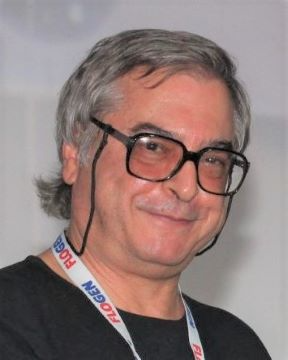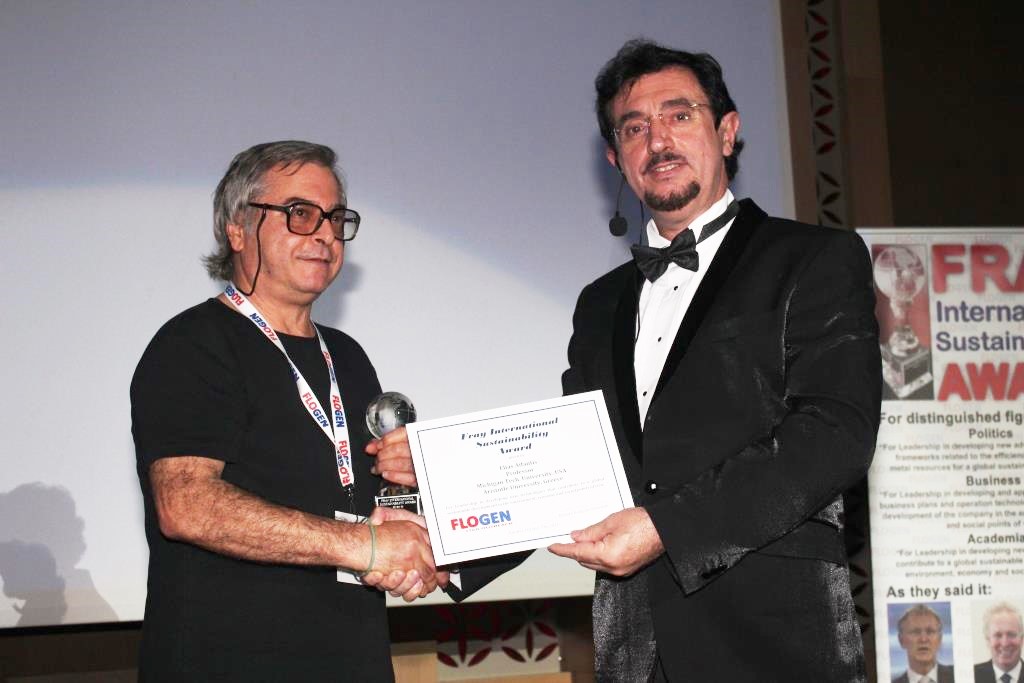About Award Winners
Politics |
Corporations |
Academia |
Research Institutions

Sustainable multiscale material mechanics
In October 2015 Elias C. Aifantis will celebrate 2 milestone anniversaries: 65 years of age and 40 years of research contributions (since 1975 after his PhD from the University of Minnesota) while holding academic posts at the Universities of Illinois at Urbana-Champaign, University of Minnesota and Michigan Tech in US, as well as Aristotle University of Thessaloniki in Greece.
During this period he has promoted highly interdisciplinary work by bringing into the field of solids mechanics ideas from diffusion theory, chemical reactions, and nonlinear physics.
Among his initial contributions, while at the University of Illinois, was the development of stress-assisted diffusion theories for hydrogen embrittlement and stress corrosion cracking with applications to chemo-mechanical damage theories in metals, as well as of flow through double porosity media theories with applications to consolidation and subsidence in geo-materials. This work motivated the concept of viewing a stressed solid as an active medium the deformation of which is governed by the production/annihilation and transport of defect populations and led to the development of the first models to interpret self-organization of dislocations and deformation patterning. The Walgraef-Aifantis (W-A) model was among the firsts to predict widths and spacing of the layered dislocation structure of the persistent slip bands observed in fatigued crystals, and was discussed in Chapter 6 of the Nobelist's Ilya Prigogine book “Exploring Complexity”, Freeman, New York (1989). As an alternative to this approach, a large number of follow-up papers was generated on discrete dislocation (DD) dynamics simulations (e.g. Kubin, Ghoniem, Bulatov, van der Giessen/ Needleman, Zbib/Hirth and others), and more recent dislocation-density based simulations using statistical mechanics (Groma, El-Azab, Zaiser, Hochrainer, Ngan and others).
Another important contribution, jointly with Regents Professor of Mathematics Jim Serrin, in the early eighties while at the University of Minnesota, was the revisit of Maxwell's rule and van der Waals's theory of fluid interfaces within a strictly mechanical framework incorporating higher order density gradients in the interfacial stress tensor. Among the results were the relocation of Maxwell's line and the derivation of transition, reversal and periodic solutions for fluid interfaces. This, as well as subsequent work with Triantafyllidis on gradient non-linear elasticity, preceded related work on necking of polymeric fibers (Coleman and coworkers), and on phase transitions/martensitic transformations (Gurtin, Slemrod, James, Truskinovski and others).
Later in mid-eighties, while at Michigan Tech, he proposed the first gradient plasticity theory to predict the thickness of shear bands and eliminate the mesh-size dependence of FE calculations in the strain softening regime. This was used in FE codes developed by de Borst, Tomita and others to solve large-scale engineering problems for which classical plasticity did not apply. Other gradient plasticity models, such as those proposed by Fleck/Hutchinson/Ashby, Gao, Nix/Huang and co-workers, were developed later in the mid-nineties and a large number of researchers throughout the world are working today on such theories for interpreting size effects and other phenomena at the micron scale. It has also led to a revival of Eringen's nonlocal elasticity theory.
In the early and mid-nineties, jointly with his experimental collaborators Milligan and Hackney at Michigan Tech, he initiated a project on nanostructured materials and “coined” the term “nanomechanics” as he did earlier with “dislocation patterning” and “material instabilities”. They identified, theoretically and experimentally, the critical grain size regime where a plasticity transition occurs from grain rotation/sliding in the absence of dislocation activity to intergranular avalanche-like dislocation motion. This mechanism has also been confirmed by MD numerical experiments performed by Swygenhoven's group in Switzerland. For bulk nanocrystals, they discovered another plasticity transition mechanism controlled by “multiple” or “massive” shear banding without any hardening, not observed for the conventional grain size counterparts of these materials, which are always strain-hardened. Such multiple shear band mechanism has also been experimentally documented recently for metallic glasses and nanoscale materials (e.g. Ma, Greer, Gleiter). The first mechanical models at the nanoscale to explain the observed behavior were developed at that time and these models are currently being improved for applications to nanotechnology.
Since 2000, while at the Aristotle University of Thessaloniki, where he was honored (metaklisi) to succeed the late Professor George Lianis (a distinguished professor of Mechanics at Purdue who was offered the Chair of Mechanics of Aristotle University and later assigned by Prime Minister Papandreou to initiate the reform of higher education and research in Greece), he continued his earlier work on gradient elasticity and gradient plasticity with applications at the nanoscale with students and postdocs. In particular, his gradient elasticity (GradEla) model, which was used (in collaboration with coworkers Altan, Ru, Unger) to eliminate singularities from dislocation lines and crack tips. His earlier theory of gradient plasticity was enhanced (in collaboration with Zaiser) with stochastic terms to model the competition between deterministic strain gradient and random microstructures became a popular topic in Greece (Vardoulakis, Aravas, Giannakopoulos, Exadaktylos, Georgiadis) and elsewhere (EU, US, China).

Prof. Elias Aifantis, Receiving the Fray International Sustainability Award from Dr. Florian Kongoli at FLOGEN SIPS 2015